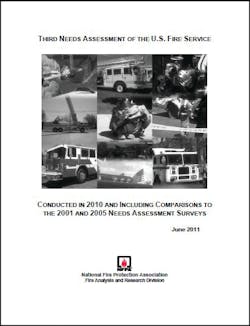The majority of U.S. fire departments admit they can't handle challenging incidents with local resources.
The NFPA's Third Needs Assessment of the U.S. Fire Service also shows: "fire service needs are extensive across the board, and in nearly every area of need, the smaller the community protected, the greater the need."
"There has been little change in the ability of departments, using only local resources, to handle certain types of unusually challenging incidents, including two types of homeland security scenarios (structural collapse and chem/bio agent attack) and two types of largescale emergency responses (a wildland/urban interface fire and a developing major flood)," researchers concluded.
The report card compares the needs' assessment results of 2001 and 2005.
Some needs areas have shown declines such as in personal protective and firefighting equipment -- two types of resource that received the largest shares of funding from the Assistance to Firefighters grants, according to the report.
"Some innovative technologies that have not been identified as necessary in existing standards but are known to be very useful to today's fire service -- including Internet access and thermal imaging cameras -- have also seen large increases in use," they said.
The 2010 survey also saw a decline in needs have been more modest in some other important areas, such as training, which have received much smaller shares of AFG grant funds.
Still other areas of need, such as apparatus, stations, and the staffing required to support the stations, have seen either limited reductions in need (e.g., apparatus needs in rural areas) or no reductions at all (e.g., adequacy of stations and personnel to meet standards and other guidance on speed and size of response), according to the survey.
Needs related to a sufficiency of equipment have seen the greatest reductions, while needs related to advanced capabilities of equipment have seen smaller but still noteworthy reductions.
Among the findings:
*Except for cities protecting at least 250,000 population, most cities do not assign at least 4 career firefighters to an engine or pumper and so are probably not in compliance with NFPA 1710, Standard for the Organization and Deployment of Fire Suppression Operations, Emergency Medical Operations, and Special Operations to the Public by Career Fire Departments, which requires a minimum of 4 firefighters on an engine or pumper.
*Lack of success in meeting need: Half (46%) of all fire departments that are responsible for structural firefighting have not formally trained all their personnel involved in structural firefighting, down from 55% in 2001 and 53% in 2005.
*Lack of success in meeting need: Half (48%) of all fire departments that are responsible for emergency medical service (EMS) have not formally trained all their personnel involved in EMS, down from 54% in 2001 and 53% in 2005.
*Lack of success in meeting need: Two-thirds (65%) of all fire departments that are responsible for hazardous material response (Hazmat) have not formally trained all their personnel involved in Hazmat, down from 73% in 2001 and 71% in 2005.
*Lack of success in meeting need: Two-thirds (68%) of all fire departments that are responsible for wildland firefighting have not formally trained all their personnel involved in wildland firefighting, down from 75% in 2001 and 74% in 2005.
*Lack of success in meeting need: Six out of seven (85%) fire departments that are responsible for technical rescue have not formally trained all their personnel involved in technically unchanged, largely unchanged from 88% in 2001 and 2005.
*Half (51%) of all fire departments do not have enough portable radios to equip all emergency responders on a shift, but this is down from 77% in 2001 and 65% in 2005.
*Nearly two-thirds (65%) of radios do not have water resistance, but this is down from 77% in 2001 and 75% in 2005.
*About three-fourths (74%) of radios are not intrinsically safe in an explosive atmosphere, but this is down from 85% in 2001 and 82% in 2005.
*More than two-thirds (71%) of departments do not have enough radios to provide a reserve equal to or greater than 10% of in-service radios, but this is down from 82% in 2001 and 78% in 2005.
*Half (51%) of all fire departments cannot equip all firefighters on a shift with selfcontained breathing apparatus (SCBA), but this is down from 70% in 2001 and 60% in 2005.
About the Author
Susan Nicol
News Editor
Susan Nicol is the news editor for Firehouse.com. She is a life member and active with the Brunswick Volunteer Ambulance & Rescue Company, Oxford Fire Company and Brunswick Vol. Fire Co. Susie has been an EMT in Maryland since 1976. Susie is vice-president of the Frederick County Fire/Rescue Museum. She is on the executive committee of Frederick County Volunteer Fire and Rescue Association. She also is part of the Maryland Institute for Emergency Medical Services Systems (MIEMSS) Region II EMS Council. Susie is a board member of the American Trauma Society, Maryland Division. Prior to joining the Firehouse team, she was a staff writer for The Frederick News-Post, covering fire, law enforcement, court and legislative issues.

